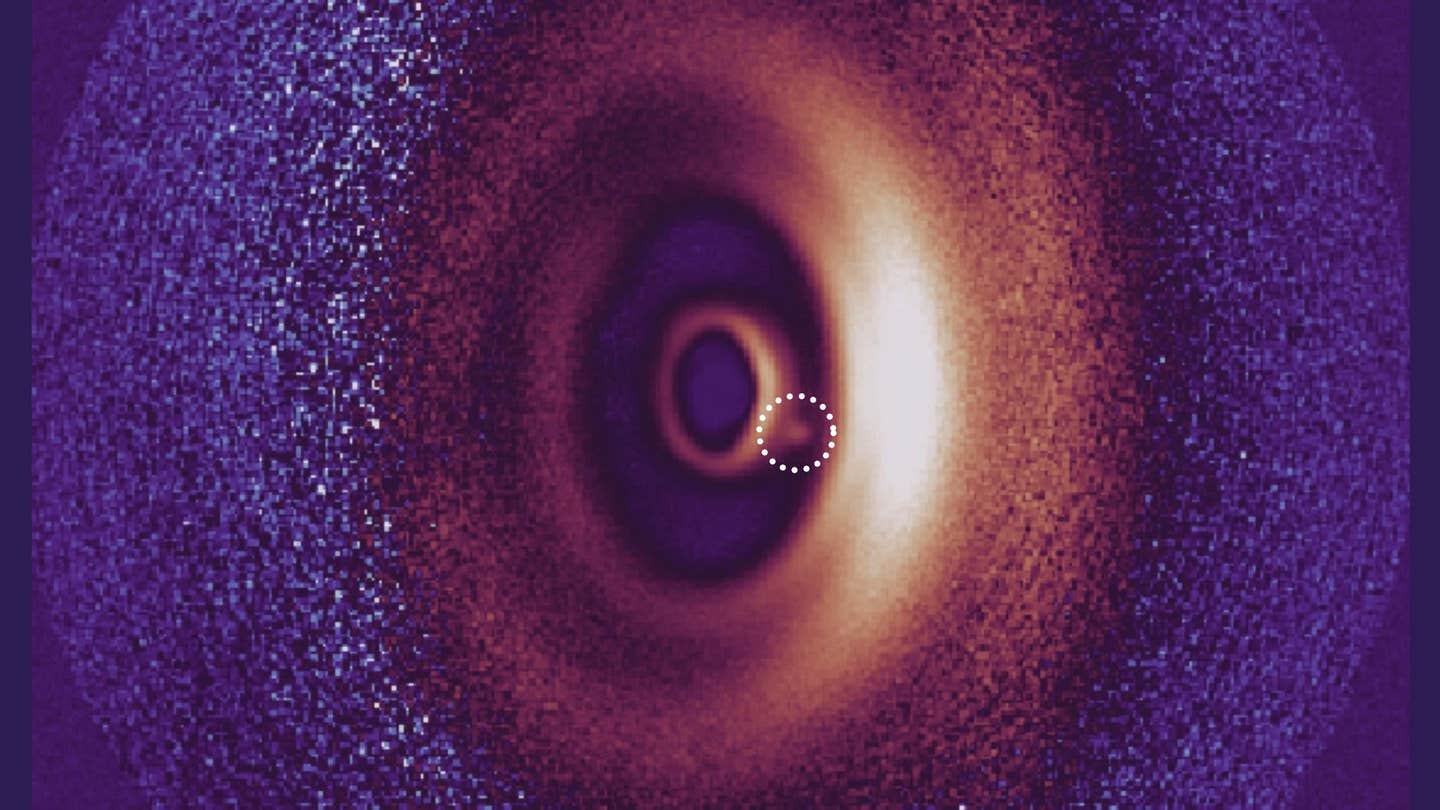Astronomers discover a newborn gas-giant exoplanet circling a young 5 million-year-old star
Astronomers spot WISPIT 2b, a newborn gas giant forming around a young Sun-like star, reshaping theories of planet formation.

A team of young astronomers has captured WISPIT 2b, a baby gas giant still forming around a Sun-like star, offering rare insight into how planets grow. (CREDIT: C. Ginski/R. van Capelleveen et al/PA Wire)
A group of young astronomers has captured something few people ever get to see: a planet in the middle of its own creation. The discovery, made using the European Southern Observatory’s Very Large Telescope in Chile, has given scientists a striking view of a giant world forming inside the dusty rings around a star.
The new planet, named WISPIT 2b, orbits a star much like our Sun but only about 5 million years old. That’s practically an infant on the cosmic scale, since our own solar system is more than 4.5 billion years old. For astronomers, spotting this planet is like catching a baby picture of a gas giant, glowing hot from birth and still feeding on the gas around it.
An Unexpected Find
The story began when researchers took quick snapshot images of several young stars. Each one received only a few minutes of telescope time to see if a planet might appear as a faint dot of light nearby. What they found around one star stunned them.
Instead of a simple disk of dust, the images revealed a dramatic system of rings stretching out 380 times farther than the distance between Earth and the Sun. Within one of those gaps sat the clear signal of a newborn planet.
Dr. Christian Ginski, lecturer at the University of Galway and second author of the study, recalled the moment: “When we saw this multi-ringed disk for the first time, we knew we had to try and see if we could detect a planet within it, so we quickly asked for follow-up observations.”
The follow-up did not disappoint. The planet was captured in near-infrared light, which revealed its glow from the heat of formation. Observations from the University of Arizona added another layer of proof when the planet was spotted in visible light at a wavelength linked to hydrogen gas. This showed that WISPIT 2b is still pulling in material to build its atmosphere.
Related Stories
- Exoplanets may capture dark matter and collapse into black holes
- Astronomers find exoplanets are far larger than previously believed
Why This Planet Stands Out
WISPIT 2b is estimated to be four to ten times the mass of Jupiter, making it a true heavyweight. It circles its star at a distance of 57 astronomical units, nearly twice the distance Neptune sits from our Sun. What makes it especially valuable to science is its timing.
Only one other planet like this has ever been confirmed at such an early stage around a young Sun-like star, back in 2018. WISPIT 2b now becomes the first planet clearly seen inside a multi-ringed disk, offering scientists the rare chance to watch how a forming world interacts with the very structure that gave it life.
According to Dr. Ginski, “Capturing an image of these forming planets has proven extremely challenging, and it gives us a real chance to understand why the many thousands of older exoplanet systems out there look so diverse and so different from our own solar system.”
A Glimpse Into the Distant Past
The WISPIT 2 system offers more than just a discovery; it serves as a time machine. Four and a half billion years ago, our own Sun and planets emerged from a similar swirling disk of dust and gas. By studying this young system, researchers can piece together how Earth and its neighbors came to be.
Richelle van Capelleveen, a PhD student at Leiden University and lead author of the study, said: “Discovering this planet was an amazing experience—we were incredibly lucky. WISPIT 2, a young version of our Sun, is located in a little-studied group of young stars, and we did not expect to find such a spectacular system.”
For van Capelleveen and her colleagues, WISPIT 2b provides a benchmark case, one that will be used again and again to test theories about how planets form.
A New Chapter in Planet Formation Theories
For decades, scientists debated whether massive gas giants so far from their stars could form slowly or only by quick collapse of a gas cloud. WISPIT 2b tips the scales in favor of gradual growth, known as core accretion. That process involves a planet starting as a rocky core, then slowly pulling in surrounding gas to grow larger.
Because the planet is still hot and glowing, astronomers now have a rare chance to watch how it grows and changes right after birth. These observations may help explain why some planetary systems end up with gas giants close to their stars, while others look more like our solar system with widely spaced orbits.
Chloe Lawlor, a doctoral student at the University of Galway, summed up the excitement: “WISPIT 2b, with its position within its birth disk, is a beautiful example of a planet that can be used to explore current planet formation models. I am certain this will become a landmark paper.”
The Human Side of the Discovery
What makes this achievement especially inspiring is who made it happen. The work was led by early-career scientists, including van Capelleveen and a team of graduate students at Galway. Together with Dr. Ginski and colleagues at the University of Arizona, they coordinated international observations that confirmed the planet.
Jake Byrne, a master’s student at Galway, described his reaction: “The planet is a remarkable discovery. I could hardly believe it was a real detection when Dr. Ginski first showed me the image. It’s a big one—that’s sure to spark discussion within the research community and advance our understanding of planet formation.”
Another Galway student, Dan McLachlan, put the discovery into perspective: “Sometimes you can get so focused on a small task and you forget about the big picture, and when you zoom out and take in the magnitude of what you are working on it shocks you. This was one such project—an exoplanet direct detection!—and it was such a mind-blowing thing to be a part of.”
Dr. Ginski emphasized how proud he was of the younger researchers, saying, “We were so fortunate to have these incredible young researchers on the case. This is the next generation of astrophysicists who I am sure will make more breakthrough discoveries in the years to come.”
A Long Road of Observation
The planet was found during a five-year project designed to learn whether giant planets with wide orbits are more common around young or old stars. That broad goal ended with the unexpected surprise of WISPIT 2b.
The discovery has already been recognized with two scientific papers published in Astrophysical Journal Letters. One, led by the Leiden and Galway team, announced the infrared detection. The other, from the University of Arizona, detailed the visible light confirmation. Together, they create the strongest evidence yet that astronomers have caught a giant planet mid-formation.
Practical Implications of the Research
This discovery does more than mark a milestone in astronomy—it reshapes how we understand the birth of planetary systems. By proving that gas giants can slowly form even far from their stars, the research challenges long-held ideas and opens the door to new models of planetary growth.
For people on Earth, the findings help us see our own origins more clearly. Every step in understanding planet formation brings us closer to knowing why Earth became habitable, while other worlds did not.
In the future, WISPIT 2b will serve as a testing ground for new theories and instruments, pushing astronomy forward and offering humanity a clearer picture of its place in the cosmos.
Summary: Key Facts About WISPIT 2 System
- Star (WISPIT 2): A young, Sun-like star about 5 million years old.
- Disk: Broad system of rings, stretching out to 380 AU.
- Planet (WISPIT 2b): Embedded in a gap about 57 AU from the star.
- Planet size: Estimated at 4–10 times the mass of Jupiter.
- Imaged in near-infrared: Showing it’s glowing from heat of formation.
- Detected in visible light (H-alpha): Showing it’s still actively gathering gas.
- Research led by early-career scientists, marking a significant achievement in astronomy.
Note: The article above provided above by The Brighter Side of News.
Like these kind of feel good stories? Get The Brighter Side of News' newsletter.



